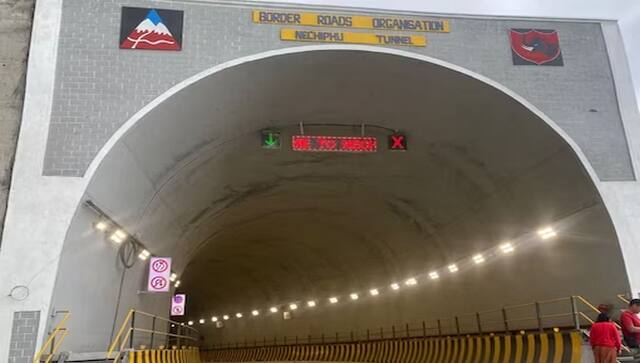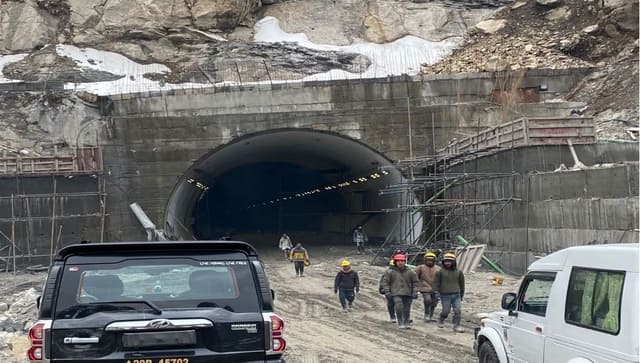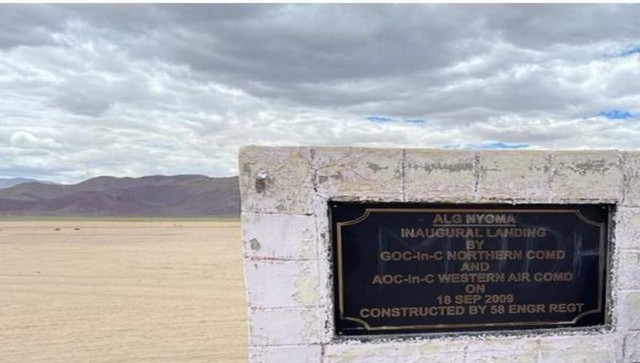Defence minister Rajnath Singh on Tuesday laid the foundation for the world’s highest airfield in Ladakh. Singh also inaugurated 90 infrastructure projects constructed by the Border Roads Organisation (BRO) at a cost of Rs 2,941 crore. These include the state-of-the-art 422.9 metre Devak bridge on the Bishnah-Kaulpur-Phulpur Road in Jammu and Kashmir’s Samba, and the Nechiphu tunnel and Sela tunnel in Arunachal Pradesh. But how is India upgrading its border infrastructure? And why is it doing so? Let’s take a closer look: Nyoma Airfield to come up in Ladakh Located at a height of 13,400 feet, Nyoma is around 46 kilometres from the Line of Actual Control with China. The Border Roads Organisation will construct the airfield at an estimated cost of Rs 218 crore at the strategically-located Nyoma belt in eastern Ladakh. The existing Nyoma Advanced Landing Ground (ALG) has been used to transport men and materials during the ongoing stand-off with China – and has seen operations of Chinook heavy-lift choppers and the C-130J special operations aircraft. As per The Print, the ALG is actually a runway made of mud – allowing only specialised transport aircraft such as the Chinook and C-130J aircraft to land.
The ALG was established in 1962, as per The Statesman.
Defence sources said the airfield will comprise a 2.7-kilometre concrete runway with associated infrastructure. Such infrastructure includes a hangar and a crash bay accommodation shelter, as per N_ews9._ As per The Print, the new runway, once complete, will allow heavier transport craft to operate out of Nyoma. Work will be concluded in less than 20 months and fighter engines are currently being tweaked to allow them to operate from such heights. The airfield will add to the Indian military’s strategic depth. News9 quoted BRO director Lt Gen Rajeev Chaudhry as saying, “It is going to be the highest fighter base in the world. It will be strategically very important.” “This airfield is being developed as a staging ground for forward troops deployment. This airfield will be able to take all kinds of aircraft, including fighters, as well as transport. It will give a strategic reach and edge to the Indian Air Force as well as the Indian Army in case more deployment is required. In case of any conflict with adversaries, this airfield will be of immense logistical and operational importance,” Chaudhry added. Once fully built, Nyoma will be the closest airfield near the China border. Chaudhary said the BRO is aiming to finish building the airfield by mid-2025. “That’s the fastest because, in such difficult terrain, we get a working window of just around six months in a year,” he added. BRO projects The BRO projects include 22 roads, 63 bridges, one tunnel, two airstrips and two helipads across 10 border states and Union Territories of northern and northeastern regions constructed under challenging weather conditions, at most inhospitable terrain locations. Of the 89 projects inaugurated virtually, 36 are in Arunachal Pradesh, 25 in Ladakh, 11 are in Jammu and Kashmir, five in Mizoram, three in Himachal Pradesh, two each in Sikkim, Uttarakhand and West Bengal and one each in Nagaland, Rajasthan and Andaman and Nicobar Islands. The BRO completed the critically strategic projects in record time and several of them were constructed in a single working season using state-of-the-art technology. The 500-metre Nechiphu Tunnel on Balipara-Charduar-Tawang Road in Arunachal Pradesh will provide all-weather connectivity to the strategic Tawang region.
The Arunachal Observer quote defence experts as saying the Nechiphu Tunnel would be critical to neutralising a threat from China.
The outlet quoted BRO sources as saying, “The tunnel has been conceived to bypass the extreme foggy conditions prevailing around Nechiphu Pass, which have caused hindrance to general traffic and military convoys for many decades.” [caption id=“attachment_13115632” align=“alignnone” width=“640”] The Nechiphu tunnel will provide all-weather connectivity to the strategic Tawang region. News18[/caption] The tunnel will also be beneficial to tourists visiting pristine Tawang – allowing all-weather travel and cutting down on the time taken to reach Tawang by at least half hour. It will also reduce by seven kilometres the distance to Tawang through the heavily foggy stretch. Sources told the outlet it would reduce the carbon footprint in the eco-sensitive area. The tunnel, which would allow two-way traffic, also has modern lighting and safety facilities. The Sela tunnel in Arunachal Pradesh is the world’s lengthiest twin-lane tunnel above 13,000 feet, as per Hindustan Times. It will allow speedy deployment of soldiers and weapons to be deployed to Tawang’s forward areas. The tunnel will also reduce travel time to Tawang by at least an hour and also provide all-weather connectivity. [caption id=“attachment_13115652” align=“alignnone” width=“640”]
The Nechiphu tunnel will provide all-weather connectivity to the strategic Tawang region. News18[/caption] The tunnel will also be beneficial to tourists visiting pristine Tawang – allowing all-weather travel and cutting down on the time taken to reach Tawang by at least half hour. It will also reduce by seven kilometres the distance to Tawang through the heavily foggy stretch. Sources told the outlet it would reduce the carbon footprint in the eco-sensitive area. The tunnel, which would allow two-way traffic, also has modern lighting and safety facilities. The Sela tunnel in Arunachal Pradesh is the world’s lengthiest twin-lane tunnel above 13,000 feet, as per Hindustan Times. It will allow speedy deployment of soldiers and weapons to be deployed to Tawang’s forward areas. The tunnel will also reduce travel time to Tawang by at least an hour and also provide all-weather connectivity. [caption id=“attachment_13115652” align=“alignnone” width=“640”] The Sela tunnel will allow speedy deployment of soldiers and weapons to be deployed to Tawang’s forward areas. News18[/caption] The Devak bridge is of strategic importance to the defence forces. “The main focus is state of the art 422.9 meter long, Class 70 RCC Devak Bridge on Bishnah-Kaulpur-Phulpur Road in Jammu & Kashmir. This bridge is of strategic importance to our defence forces and will facilitate speedy induction of troops, heavy equipment and mechanised vehicles to forward areas and will also boost socio-economic development of the region,” official told IndiaTVNews.com. Singh also inaugurated the reconstructed and revamped Bagdogra and Barrackpore airfields in West Bengal. These airfields have been successfully reconstructed by the BRO at a cost of Rs 529 crore. These airfields will not only improve the defensive and offensive architecture of the Indian Air Force along the northern borders but will also facilitate commercial flight operations in the region. Why is this happening? The developments come in the backdrop of India’s border stand-off with China since 2020.
The Sela tunnel will allow speedy deployment of soldiers and weapons to be deployed to Tawang’s forward areas. News18[/caption] The Devak bridge is of strategic importance to the defence forces. “The main focus is state of the art 422.9 meter long, Class 70 RCC Devak Bridge on Bishnah-Kaulpur-Phulpur Road in Jammu & Kashmir. This bridge is of strategic importance to our defence forces and will facilitate speedy induction of troops, heavy equipment and mechanised vehicles to forward areas and will also boost socio-economic development of the region,” official told IndiaTVNews.com. Singh also inaugurated the reconstructed and revamped Bagdogra and Barrackpore airfields in West Bengal. These airfields have been successfully reconstructed by the BRO at a cost of Rs 529 crore. These airfields will not only improve the defensive and offensive architecture of the Indian Air Force along the northern borders but will also facilitate commercial flight operations in the region. Why is this happening? The developments come in the backdrop of India’s border stand-off with China since 2020.
As per The Print, Beijing has made significant upgrades to its bases along the LAC including lengthier runways and hardened shelters.
China has also built new heliports in Tianshuihai near the Galwan Valley – the site of the clash in 2020 –and in Rutog County near Pangong Tso. Sources told the outlet India’s goal is to counter China’s Anti Access Area Denial (A2AD) strategy which involves curbing the enemy’s freedom of movement on the battlefield by deploying an assortment of surface-to-air missiles, long-range radar, artillery, rockets, soldiers and armoured vehicles. As per The Hindu, China has also upgraded roads opposite eastern Ladakh and strengthened alternate approaches around its Moldo garrison opposite the south Bank of Pangong Tso. This came after the Indian Army in August 2020 deployed tanks and troops on mountain peaks in the Kailash range overlooking the gap. Indian officials said the surge in road and bridge construction by the BRO in the last three years has led to the completion of several critical and strategic projects which has bolstered the defence preparedness. Chaudhry earlier said that India will beat China in the next two to three years as the Narendra Modi-led NDA government is proactively working towards developing infrastructure along the 3,488-km stretch of the Line of Actual Control. He said 295 projects have been completed worth ₹ 11,000 crore in the past two to three years. The BRO has also connected the farthest and most remote villages of the country like Huri in Arunachal Pradesh to the mainland. This connectivity has triggered reverse migration along the border villages. Last year, 103 BRO infrastructure projects were completed at a cost of Rs 2,897 crore while in 2021, 102 BRO infrastructure projects were dedicated to the nation at a cost of Rs 2,229 crore. Comparing the ruling dispensation with the previous governments regarding infrastructure development along borders, the BRO chief said that China started their push for infrastructure development all along LAC much before India, and a decade ago, our thinking about infrastructure development along the 3,488 Km stretch was a little bit defensive. “But now the present government has changed this thinking and policy and is supporting us with a budget along with all other vehicles and machines to accelerate our work all along the LAC,” he said. Highlighting the budget earmarked for the development of infrastructure along the LAC by the central government in recent years, Chaudhry said, “In 2008, our budget used to be approximately ₹ 3,000 crore. In 2017 it increased to ₹ 5,000-6,000 crore. In 2019, it went up to ₹ 8,000 crore and increased thereafter. And in the last year around ₹ 12,340 crore were spent.” With inputs from agencies
)